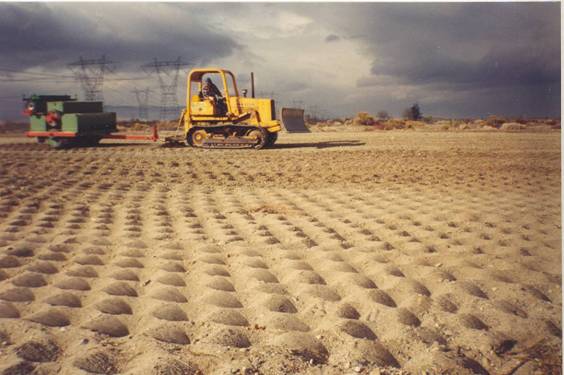
Imprinting Technology for Restoring Vegetation on Degraded Drylands
September 23, 2003
Robert M. Dixon, Ph.D* and Ann B. Carr
Introduction. Vast areas of land have been severely degraded by human activities in semiarid and arid regions of the world and now need to be revegetated to control erosion and restore biomass production. However, low-cost methods that work have not been available to accomplish this task on a broad scale.
Procedure. To undergird the development of new techniques for restoring vegetation on degraded drylands, the important factors affecting rainwater infiltration were reviewed in the literature and then extensive infiltration studies were conducted from 1960 to 1976 under a wide range of climatic, edaphic, and vegetal conditions (1,2). Using this infiltration information, a new tillage concept called land imprinting was developed (3,4), which then was implemented with a series of land imprinting devices designed, fabricated, and field tested from 1976 to the present time (5).
Results and Discussion . The above procedure led to the conclusion that 2 properties'of the soil surface--microroughness and macroporosity--exert a controlling influence over rainwater infiltration into dry soils. Manipulation of these two properties provides a one to two order-of-magnitude control over this important hydrologic property. Degraded land typically possesses a smooth, sealed soil surface with low infiltration rates, whereas productive land has a microrough and macroporous surface with high infiltration rates. The microrough, macroporous surface is able to rapidly exchange rainwater and displaced soil air across the air-earth interface, whereas this fluid exchange is greatly impeded by the smooth, sealed surface.
Thus, the key to low-cost revegetation was to develop an efficient mechanical technique for restoring stabile surface microroughness and macroporosity to, in turn, restore high infiltration. Land imprinting has proven to be a very efficient way to reshape a smooth, sealed soil surface. A number of mechanical devices have been developed and tested to apply the imprinting concept to a variety of field conditions and socio-economic settings. They have successfully established vegetation in the Sonoran Desert region of southern Arizona , USA about 90% of the time compared with about a 10% success rate using conventional methods such as drilling.
The high success rate of land imprinting is a manifestation of a number of imprinting functions or processes, all of which increase the efficiency of rainwater use in seed germination and seedling establishment. Because of the funneling or concentrating function of V-shaped imprints, less rainfall is required for seedling establishment compared with drilled furrows. The rainwater trapping function of the discontinuous imprints also reduces the amount of rainfall needed relative to continuous drilled furrows. The soil compressing function of imprinting teeth not only increases funneling efficiency, but also improves seed-soil contact and enhances upward capillary flow of soil moisture to the seedbed. Additionally, the mulching function of imprinting teeth reduces the rainfall required through suppression of surface evaporation and transpiration from existing vegetation. The foregoing imprinting functions are especially needed in dryland revegetation, but may often be of nearly equal importance in the restoration of vegetation on hillslopes in humid regions.
Since 1980, land imprinting has economically restored perennial grasses on tens of thousands of hectares of degraded rangeland in southern Arizona , alone. In conclusion, land imprinting is proving to be an important advance in soil technology for sustainable agriculture.
Literature Cited.
(1) Dixon , R. M. and A. E. Peterson. 1971. Water infiltration control: A channel system concept. Soil Sci. Soc. Am. Proc. 35: 968-973.
(2) Dixon , R. M. 1975. Design and use of closed-top infiltrometers. Soil Sci. Soc. Am. Proc. 39: 755-753.
(3) Dixon , R. M. 1980. Land Imprinter. U.S. Patent No. 4185655. U.S. Patent Office, Washington D.C.
(4) Dixon , R. M. 1983. Land imprinting for controlling infiltration and desertification processes. Pap. no. 83-2514,16p., Am. Soc. Agric. Eng., St. Joseph , MI .
(5) Dixon , R. M. and A. B. Carr. 1991. Designing land imprinters for ecological restoration. In Agronomy Abstracts. Am. Soc. Agron., Madison , WI .
Land imprinting is designed for sustainable land management
through better control of natural resources at the soil surface.Citation: Dixon , R.M. & Carr, A.B. 1994. Land Imprinting for Low-Cost Revegetation. Erosion Control 1 (3): 38-43.
The Imprinting Foundation
1616 E. Lind Road
Tucson, AZ 85719Close Window to Return to List
If you entered our site on this page, click on Logo below to go to the Imprinting Foundation for more Information

